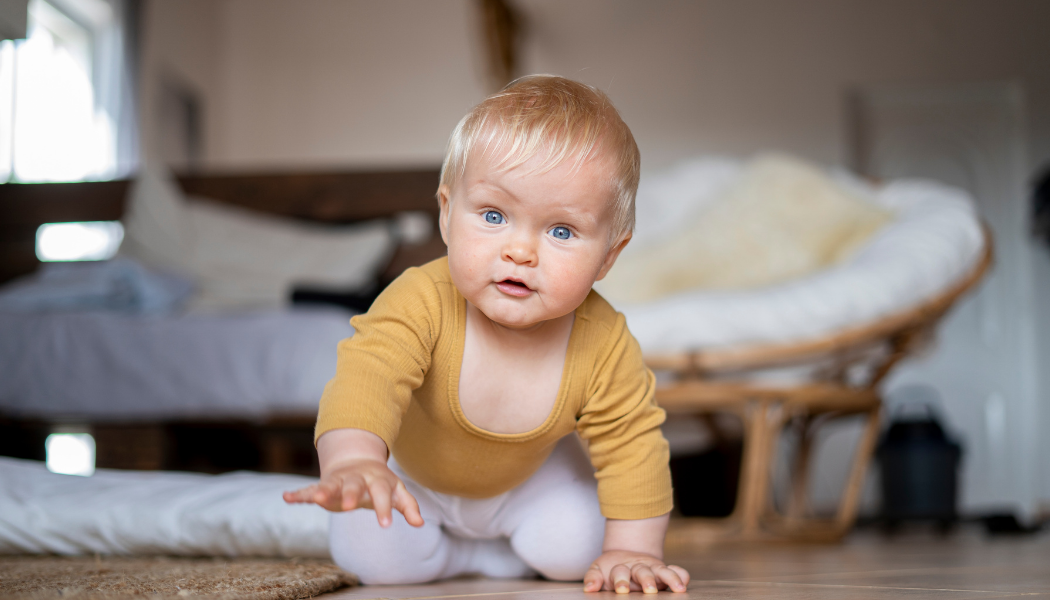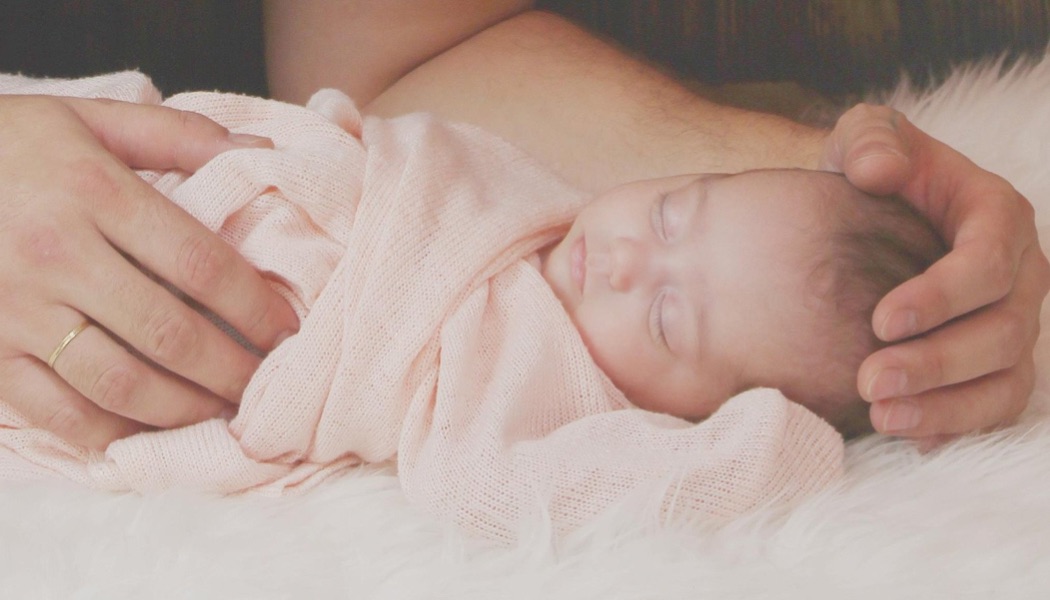I love when babies start crawling! It’s like their whole world has been opened up to them and independence begins! This post will discuss the benefits of crawling and how to help babies crawl. So get your baby gates out and start baby proofing your house because they will be on the move soon!
Kiddos can start crawling around 6 months of age (more typically 8-10 months), but it is never too late to crawl. If your child skips crawling, don’t fret! I am a huge proponent of crawling, as you’ll see from this post. But it is also important to recognize that kids are going to take the easiest form of anything, including mobility. This includes butt scooting, army crawling, rolling, or going from sitting directly to supported standing, cruising and walking. And there’s only so much we can do about it!
Importance of Independent Mobility
If your child has motor impairments, the physical exertion of crawling may not be worth it for them. In this case, working with a physical therapist may be most appropriate to find a means of independent mobility. If that child saw me for OT, would I work on crawling? I would. Maybe not for mobility, but for all the benefits I will soon mention.
It is important to encourage whatever means of mobility the child has as this promotes strengthening, social interaction, and independence. Independent mobility is a skill that allows a child to learn that he is in control of his surroundings.
Also know this: there is no current evidence that shows actual delays or impairments when kids skip crawling. So while we know there are benefits, there is a lack of evidence suggesting they are at risk for other difficulties in the future.
So, now that you should feel ok with however your child gets around, let’s start with the why… because that’s what I do.

Benefits of crawling
Below are allllll the wonderful benefits of crawling. Please check out the resources at the bottom of the page, because I’ve pulled these from my experience, various sources, and other providers. Crawling is great for:
- Weight bearing through hands to develop hand arches, strengthen fingers, wrists, and forearms
- Joint traction contributes to shoulder and scapular strengthening and stability
- A typical crawling pattern encourages symmetric, reciprocal movements essential for body awareness, midline crossing, and coordination
- Visual input provides opportunities to build visual-spatial understanding
- Open hand crawling provides tactile input to hands as they change surfaces, allowing for sensory processing experiences
- The head positions necessary to navigate the environment help build a child’s vestibular or balance sense
Now that you know the why, here are some ways that you can work on it with the child in your life.
4 Ways to Help Baby Crawl
1. Tummy Time
You’ve heard me say it before and you’ll hear it from me for forever: do as much tummy time as possible. Now sometimes, this is easier said than done. This can be challenging for many reasons. Some kids really dislike tummy time from the beginning, therefore they roll out of it as soon as they can and will avoid at all costs once they have the control. If you are battling tummy time, check out my post on it here.
If you can, try the following ways to have Baby hang out on his tummy a smidge longer. If he can realize that this is a position that can do something for him, he will likely be reinforced and motivated to return to it.
- use motivating toys or your own face! Get down on the ground with him.
- help him push through his arms and hands to straight arms
- help him bend his knees up to hands and knees position
- keep his little legs there for slightly longer by preventing him from rolling
- use some of the props below as they prevent rolling
2. Transition between positions
When children transition between sitting to tummy to laying on her back to tummy to side to sitting etc, she is building strength and coordination necessary for hands and knees crawling. Help your child do this in the following ways. Pictures included to help guide you!
Sitting to hands and knees

Sit with the child in between your legs, even if she cannot yet sit unsupported, this is a great spot for you to give the right amount of support. With your legs closer together and more snug on Baby, you’re providing more support. Further apart provides less support. Place a motivating toy on the other side of your leg and help her put her hands onto the other side of your leg.
Use the part of your leg that is the right size for Baby. If you need to bend at the knee and use your calf in front of you for a lower surface, do that (Baby would then be turned away from you). You’ll give more support at your thigh.
Side sitting and prop sitting
Encourage side sitting and propped forward sitting positions. This begins the feeling of getting weight and tactile input (or touch) into Baby’s hands. You can do this by physically putting baby’s hands onto the ground. Bang the ground with your hands as well since babies are interested in cause and effect and as imitation at this age.
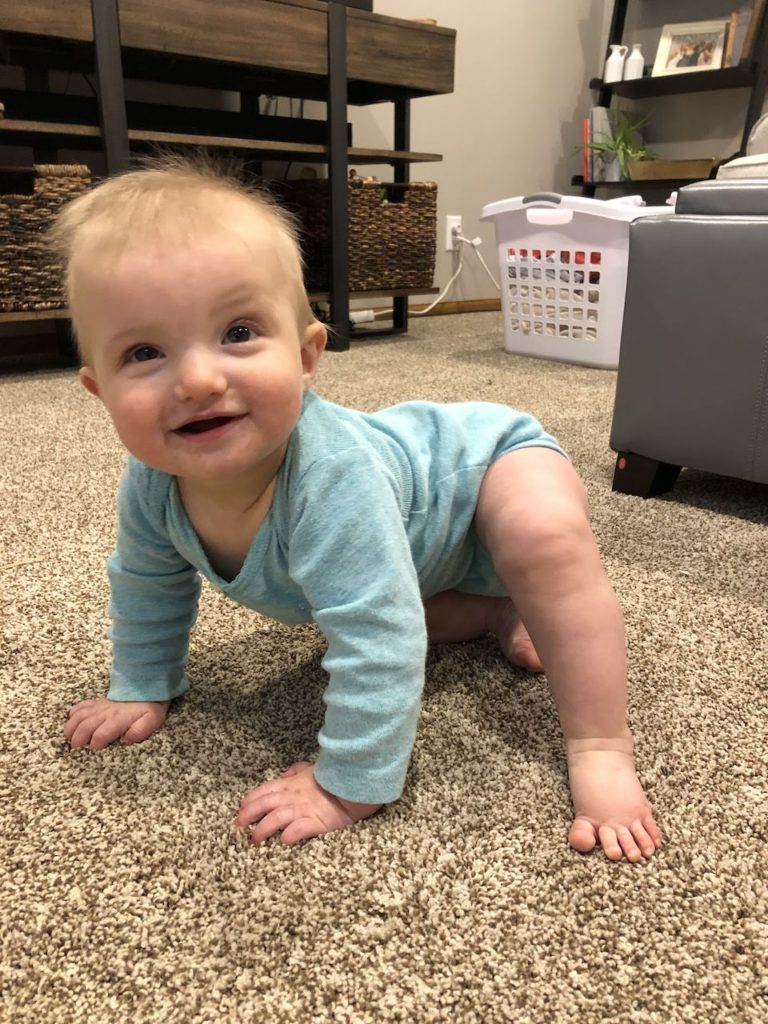
Tummy to sitting
When Baby is on his tummy, bring his knees up and bend them toward his belly. He can come onto his hands, or stay on his elbows as well. Help him flex one knee under his body to get his legs into a Z position. Now Baby should push onto hands to assume a side sitting position. Keep his weight shifted forward to keep his hands on the ground and have him keep his balance. Use motivating toys to bring Baby more centered. In fact, use motivating toys the whole way!

1. Bring knees up 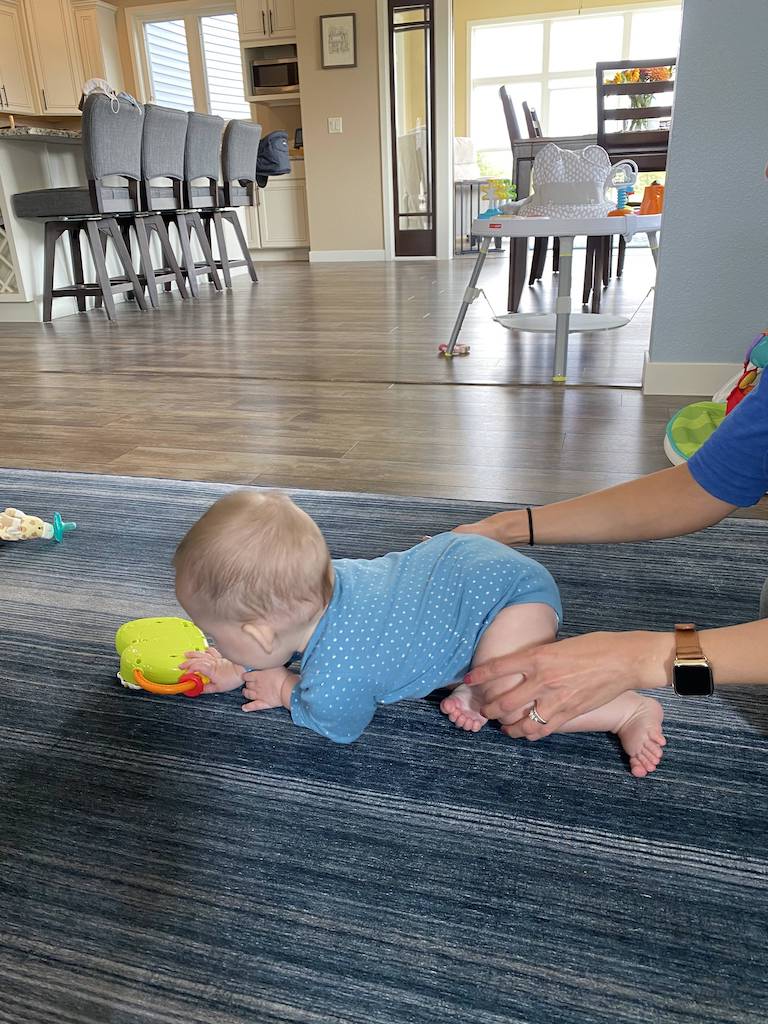
2. Bend one leg under torso 
3. Gently rotate leg out and provide downward pressure to outside knee 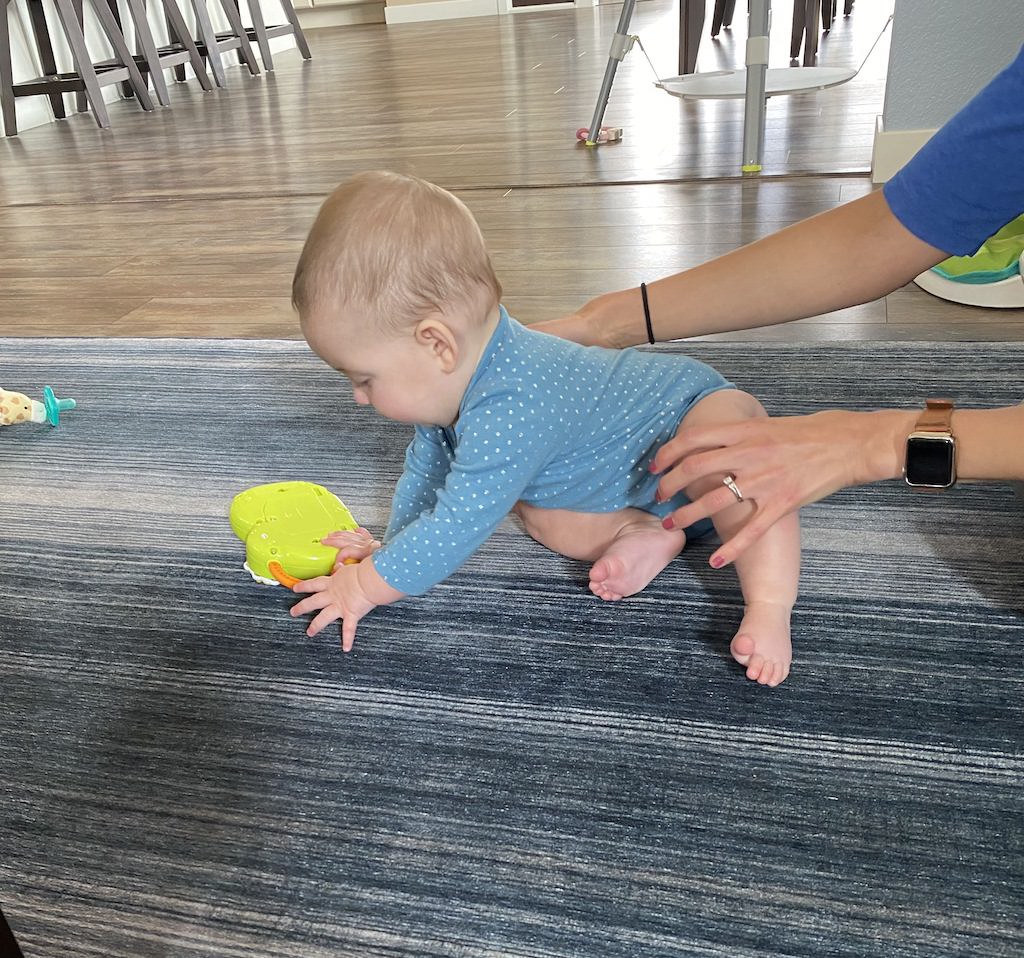
4. Provide slight assistance at trunk if needed 
5. Keep weight shifted forward to encourage her holding herself up
3. Use props
Here are some pieces of equipment that I really like to promote crawling, especially if you need to work in a modified position for a while.
- Any bolster to act as your leg in the position mentioned above. This allows for you to be fully behind Baby to help. This could be a towel roll, blanket or yoga mat rolled up, a long pillow, a Boppy pillow, a peanut ball.
- Consider Hip Huggers, which are basically tight spandex for babies with low muscle tone to keep their hips in a nice position. Definitely use these under the guidance of your therapist please!
- Use of a step stool, bottom step, or your knees bent to give her something to reach up toward. This would give motivation to come onto her knees. And using this angle, with her hands on the step, we are requiring slightly less work than straight down on the ground.
- Something to crawl under or through, such as a tunnel or simple blanket fort!
- And remember to use those highly motivating toys and siblings to lure Babe along.

4. Limit time in equipment
I love a good bouncer or activity center for kids to play in. High chairs are necessary for eating and a safe place for supported sitting. Carriers are lovely for bonding and multitasking and for those stinkers of babes that enjoy being held. Car seats are for cars only, but if Baby falls asleep in the car seat, you have my full permission to bring her in the house and leave them in the seat for a few extra glorious minutes. Walkers are helpful for when you just need to pee and you can roll that puppy in there with you.
But use these pieces of equipment for <10 minutes at a time.
Baby will likely get antsy by that time anyways and be ready to move on to the next stimulating environment. By leaving them out of these devices most of the time, you are providing an opportunity for independent mobility and strengthening.
There you have it. My recommendations that are (hopefully!) realistic. As I mentioned in the beginning, if your child did not crawl or is not crawling, don’t worry, but try some of these suggestions. And if you have older kids, check out my post on hand strengthening to incorporate crawling with older kids.
Tell me, what are your favorite ways to promote crawling for kiddos?
Why Crawling is Important for your Baby
Zero to Three- Steps To Crawling
Do Babies Need to Crawl?
The Development of Motor Behavior

